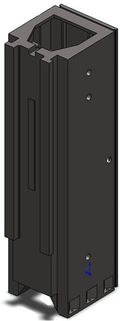(Added some text. Matrices and other data still need to be included) |
m |
||
| Line 73: | Line 73: | ||
In order to get a parameter dependent matrix |
In order to get a parameter dependent matrix |
||
<math>B_{slide}(\mu)</math> one has to pick the "active" nodes (nodes hit by tool carriage) at vertical position <math>\mu</math>. |
<math>B_{slide}(\mu)</math> one has to pick the "active" nodes (nodes hit by tool carriage) at vertical position <math>\mu</math>. |
||
| − | The "active" nodes are in the interval of <math>[\mu-\frac{d}{2},\mu+\frac{d}{2}]</math>, where d is the heigth of the slide. |
+ | The "active" nodes are in the interval of <math>[\mu-\frac{d}{2},\mu+\frac{d}{2}]</math>, where <math>d</math> is the heigth of the slide. |
To collect all these nodes a file called coord.txt is provided in [[Media:Data_VertStand.tar.gz|Data_VertStand.tar.gz]] as well. |
To collect all these nodes a file called coord.txt is provided in [[Media:Data_VertStand.tar.gz|Data_VertStand.tar.gz]] as well. |
||
| Line 87: | Line 87: | ||
To clarify this partitioning the geometrical data is given as follows: |
To clarify this partitioning the geometrical data is given as follows: |
||
| − | Width (x direction): <math>519mm</math>, |
+ | Width (<math>x</math> direction): <math>519mm</math>, |
| − | Height (y direction): <math>2010mm</math>, |
+ | Height (<math>y</math> direction): <math>2010mm</math>, |
| − | Depth (z direction): <math>480mm</math> |
+ | Depth (<math>z</math> direction): <math>480mm</math> |
==Contact== |
==Contact== |
||
Revision as of 12:58, 9 April 2013
1 Description
The vertical stand represents a structural part of a machine tool. On one of its surfaces there are guide rails located. On these rails a tool slide is moving due to the machining process the slide has to perform by the machine tool on top. The machining process produces a certain amount of heat which is transported through the structure into the vertical stand. This heat source is considered to be a temperature input at the guide rails. This transfered heat amount leads to deformations within the device induced by the prevailed temperature field denoted by  . The evolution of this field is modeled by the heat equation
. The evolution of this field is modeled by the heat equation

with the boundary conditions
 on
on  (remaining boundaries),
(remaining boundaries),
describing the heat transfer to the ambience and
 on
on  (surface where the tool slide is moving on the guide rails),
(surface where the tool slide is moving on the guide rails),
which describes the heat transfer between tool slide and vertical stand.
The heat load  induced by the slide and the external temperature
induced by the slide and the external temperature  serve as the input
serve as the input  of the corresponding state-space system.
of the corresponding state-space system.
The position of the moving slide has been included into the system as a parameter dependency  . Due to this motion the region there the input acts on the system is varying and thus one obtains a parameter dependent input matrix
. Due to this motion the region there the input acts on the system is varying and thus one obtains a parameter dependent input matrix
 .
.
Finally, the system describing the heat evolution induced by the moving heat source is given by:

where
![\begin{array}{lll}
B(\mu)&=[B_{surf}, B_{slide}(\mu)],\\
u&=[x_{ext}^T,q]^T.\\
\end{array}](/morwiki/images/math/4/b/0/4b06d8ab772cfd529264662f29fcdf3a.png)
The quantity  can be assumed as a vector including different ambient temperatures corresponding to different locations of the geometry.
can be assumed as a vector including different ambient temperatures corresponding to different locations of the geometry.
2 Data
The data file consists of the matrices

in sparse format.
Here  consists of all nodes located on the guide rails.
consists of all nodes located on the guide rails.
In order to get a parameter dependent matrix
 one has to pick the "active" nodes (nodes hit by tool carriage) at vertical position
one has to pick the "active" nodes (nodes hit by tool carriage) at vertical position  .
The "active" nodes are in the interval of
.
The "active" nodes are in the interval of ![[\mu-\frac{d}{2},\mu+\frac{d}{2}]](/morwiki/images/math/a/7/1/a71f92fd4be99066106491025fe32ad6.png) , where
, where  is the heigth of the slide.
To collect all these nodes a file called coord.txt is provided in Data_VertStand.tar.gz as well.
is the heigth of the slide.
To collect all these nodes a file called coord.txt is provided in Data_VertStand.tar.gz as well.
This file includes a column with indices followed by three additional columns filled with the coordinates  of the corresponding nodes.
of the corresponding nodes.
The matrix  describes the locations where the external temperatures act on.
The first column is responsible for the input of the temperature at the clamped bottom slice of the structure.
Column 2 describes the ... part of the stand. Columns 3 to 5 describe different thresholds with respect to the height of ambient air temperature.
The third column includes the nodes of the lower third
describes the locations where the external temperatures act on.
The first column is responsible for the input of the temperature at the clamped bottom slice of the structure.
Column 2 describes the ... part of the stand. Columns 3 to 5 describe different thresholds with respect to the height of ambient air temperature.
The third column includes the nodes of the lower third ![(y\in[0,670]mm)](/morwiki/images/math/1/5/d/15dadca59513158985b43620edf4027d.png) of the stand.
In column 4 all nodes of the middle third
of the stand.
In column 4 all nodes of the middle third ![(y\in[670,1340]mm)](/morwiki/images/math/9/2/2/9227a0d2416a1561e03190b9de4ae984.png) of the geometry are contained
and the fifth column of
of the geometry are contained
and the fifth column of  includes the missing upper
includes the missing upper ![(y\in[1340,2010]mm)](/morwiki/images/math/5/a/1/5a1482847491b222309e95bec979f0a8.png) part.
part.
To clarify this partitioning the geometrical data is given as follows:
Width ( direction):
direction):  ,
Height (
,
Height ( direction):
direction):  ,
Depth (
,
Depth ( direction):
direction): 

